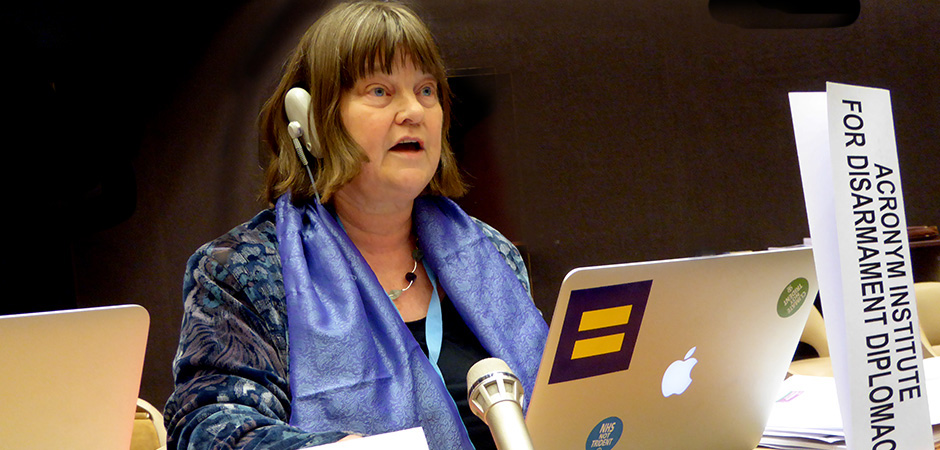Thank you Mr Chairperson,
I am speaking on behalf of the Acronym Institute for Disarmament Diplomacy, which is also a steering group partner in ICAN.
I would like to thank Dr Patricia Lewis for her very thoughtful analysis of risk, and also Ireland for introducing the consultation paper contributed by Chatham House on “Nuclear disarmament, the missing link in multilateralism” which we look forward to reading and discussing.
In the absence of any governmental representative from the United Kingdom at this UN meeting, and as I am also the spokesperson for the Green Party of England and Wales on Security, Peace and Defence, I want to say how disappointed we are not to see our government participating in this meeting – and, indeed we are deeply concerned about the irresponsibility of all the absent nuclear-armed states in not discussing with UN member states the OEWG’s issues of great importance and relevance for the safety and security for all of us.
Risks of accidents or attacks involving nuclear weapons do not only have direct consequences for the nuclear weapon possessors, but also for allies that host nuclear weapons on their territory, and, as Dr Lewis pointed out, catastrophic consequences can spread to many neighbouring countries and beyond. These are therefore important security concerns for all governments, whose highest responsibility is the safety and security of their people.
As well as the important risks she raised here and in previous Chatham House studies concerning miscalculation and near misses which could lead to nuclear detonations and even to inadvertent nuclear war, accidents frequently occur while nuclear weapons are being manufactured, transported or deployed. Eric Schlosser’s informative book “Command and Control” showed what can go wrong due to human error – the dropping of a spanner in a nuclear missile silo.
Nuclear bombs dropped from NATO airplanes in Spain and Greenland led to severe radioactive contamination, even though they did not detonate – thanks to the “sheer luck” that US General Lee Butler, Australian Foreign Minister Gareth Evans and others in the know have referred to.
And former US Defence Secretary William Perry has recently argued that nuclear risks today are actually greater than they were in the cold war.
In Britain, assembled nuclear warheads comprising high explosives packed around plutonium pits, are transported by public roads and motorways several times a year between the Atomic Weapons Establishment near London to the nuclear warhead storage depot Coulport north of Glasgow in Scotland.  These road transports share the roads with large lorries carrying highly inflammable liquids. The trucks carrying the warheads have collided with other vehicles, they’ve slipped completely off icy roads, and they have been stuck in traffic in towns.  Warheads have also been dropped while being attached to the Trident missiles in Scotland. ICAN’s UK partners have begun a “Nukes of Hazard” project this year to raise public awareness of these risks, and work with local authorities, mayors and Members of Parliament to stop these dangerous nuclear warhead transports.
While nuclear engineers seek to assure us that these weapons would not detonate if involved in an accident, it is clear that severe impact and fires have in the past, and could again in the future, caused the warheads to break apart, resulting in plutonium dispersion and massive contamination.
Whether by accident or by malign attack by terrorists, the warheads being made and transported in and between nuclear facilities could be turned into radiological “dirty” bombs, with serious humanitarian, health and economic consequences – which, as noted by Dr Lewis and others, has a gendered component – pregnant women, babies in the womb, and very young children are the most vulnerable to long-term health harm from such contamination.
These are risks that should be taken seriously wherever there are nuclear weapons activities such as manufacture, transporting and deployment, and also of course, nuclear testing, though thanks to the CTBT the risks from nuclear testing have been brought dramatically down since 1996, with only one country, North Korea, still conducting nuclear test explosions.
The nuclear bombs that are held in bases in Germany, Netherlands, Belgium, Italy and Turkey are transported by air and by road. And in recent years nuclear weapons have been flown across the United States without the pilots or anyone else being aware of their dangerous cargo.
The French and British nuclear-armed and nuclear-powered Vanguard and Triomphant submarines collided in the Atlantic in 2009, reportedly close to the Bay of Biscay, damaging each other. According to reports, one spiralled towards the seabed before control was regained. Former Royal Navy sub-mariner William McNeilly became so concerned at the number of accidents caused by human and technical errors, that he went public with information on at least 30 recent security and safety problems that could cause serious accidents, calling Trident a “disaster waiting to happen”.
And these are just examples from a few nuclear armed and nuclear weapons host countries, with much less information known about the safety and security flaws, problems, accidents and risks from the nuclear weapons manufacture, deployment and transporting in and from other nuclear-armed countries.
Because effective transparency and confidence-building information exchanges are not in place, if it weren’t for the courageous whistleblowers we wouldn’t know about the risks, problems and dangers until they blow up in our faces.
So we welcome the arguments put forward by Dr Lewis of the importance of taking the risks from nuclear weapons as seriously as the risks from civilian nuclear energy, and her call for greater transparency and confidence-building measures.
I’d like now to ask Dr Lewis and also the delegations who might be affected by nuclear weapons risks:
Do you know of any consultations and exercises that have been conducted on nuclear emergency planning, response, clean-up and mitigation in the past 10 years – whether in consideration of accidents or terrorism? If so, when, and in which countries were such consultations and exercises carried out, and did they involve regional, national and local elected representatives and authorities responsible for emergency planning, response, evacuation and clean-up, such as police and fire authorities, Red Cross and local health services, city mayors, parliamentarians and local councils?
We strongly support those delegations who have noted that transparency, CBM and mitigation measures cannot adequately address the risks – necessary though they are to increase awareness and enable emergency planners and response organisations to prepare for when the risks turn into actual disasters, whether through human or technical error, or malign attacks of physical or cyber sabotage.
The only effective way to prevent the risks becoming threats and disasters is through prevention. And the best way to build the necessary norms, rules and laws for preventing the activities that create these risks is to negotiate a universally applicable legally binding instrument or treaty that will prohibit the use, deployment, transporting and manufacture of nuclear weapons, leading to their total elimination. This is the position of ICAN, and also the policy of all the European Green Parties, as democratically adopted in 2014.
To minimise the risks pending total elimination of nuclear arsenals, the warheads should be demated – separated – from delivery vehicles, and all nuclear devices and materials stored in the possessor states at the highest levels of safety, security and guardianship.

